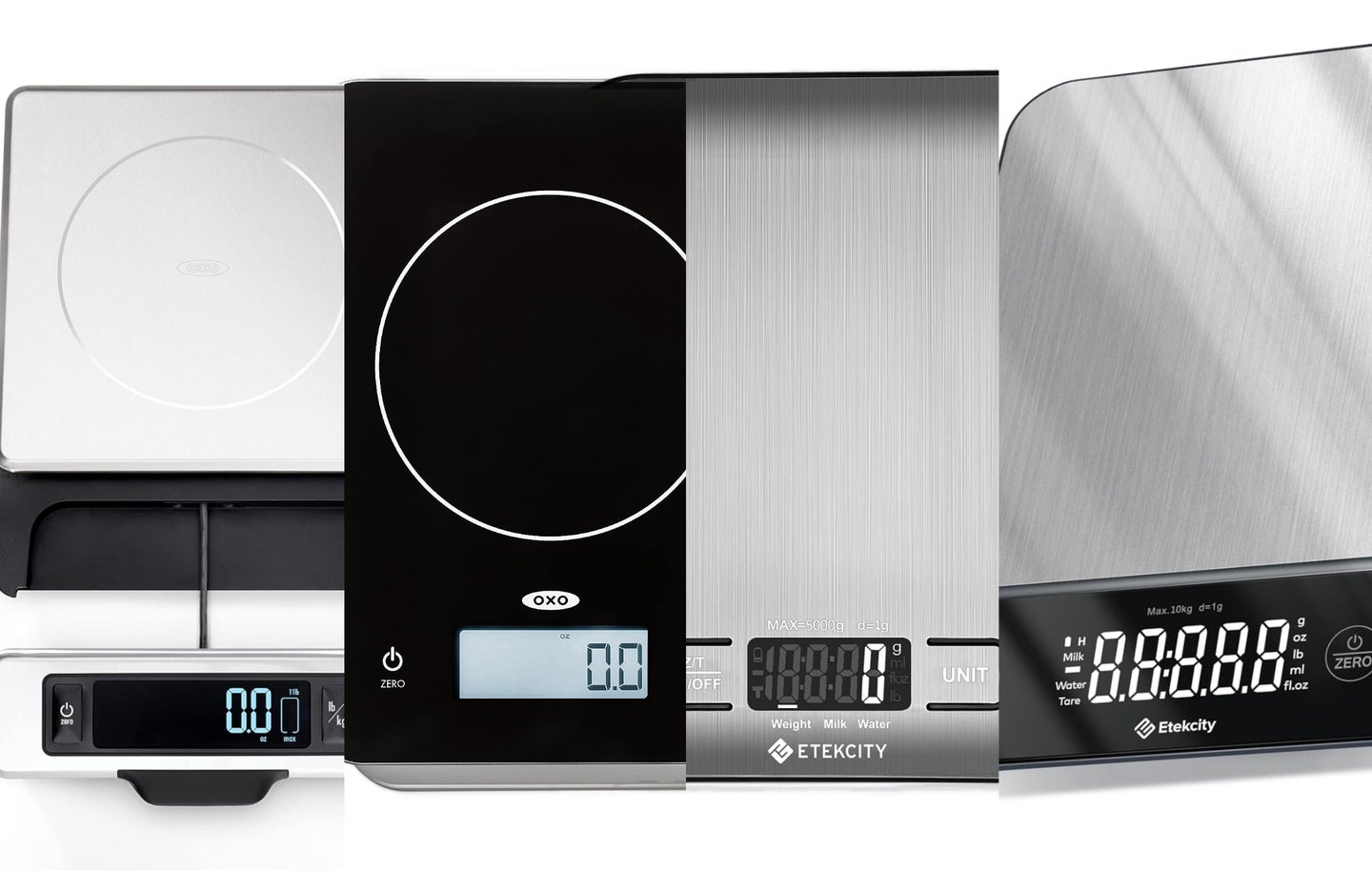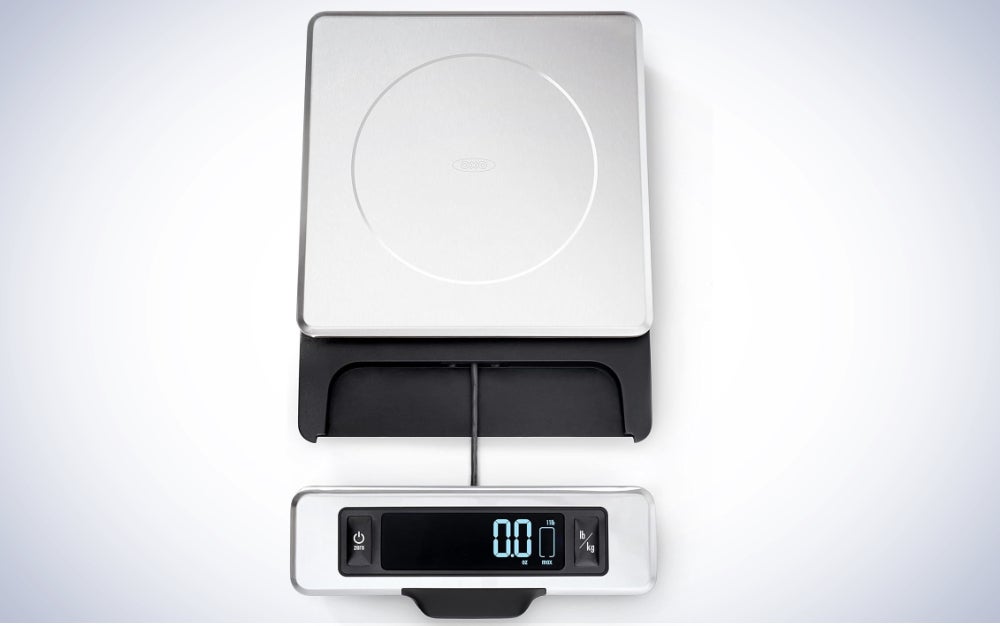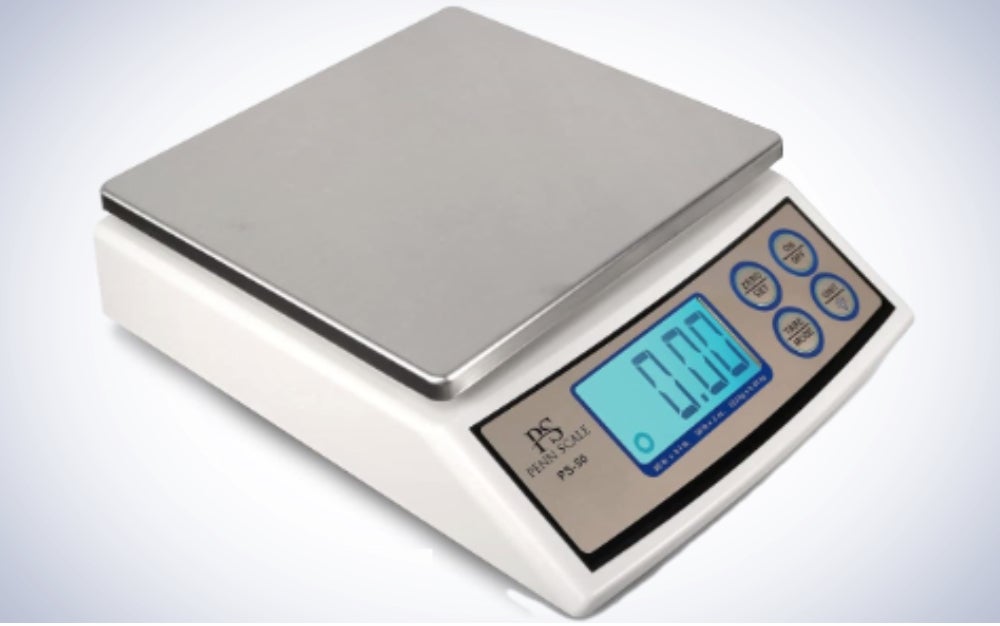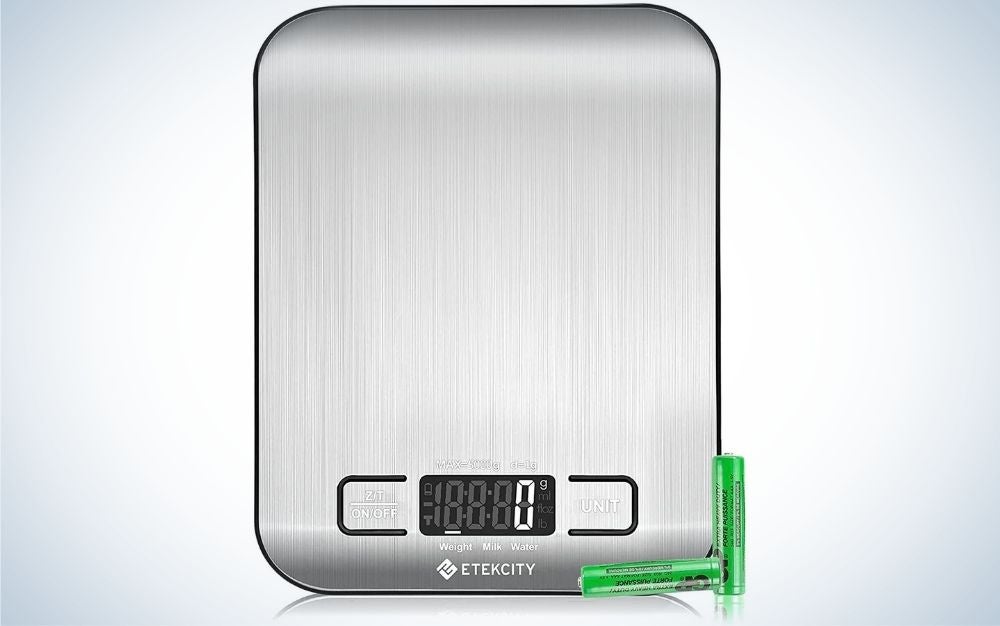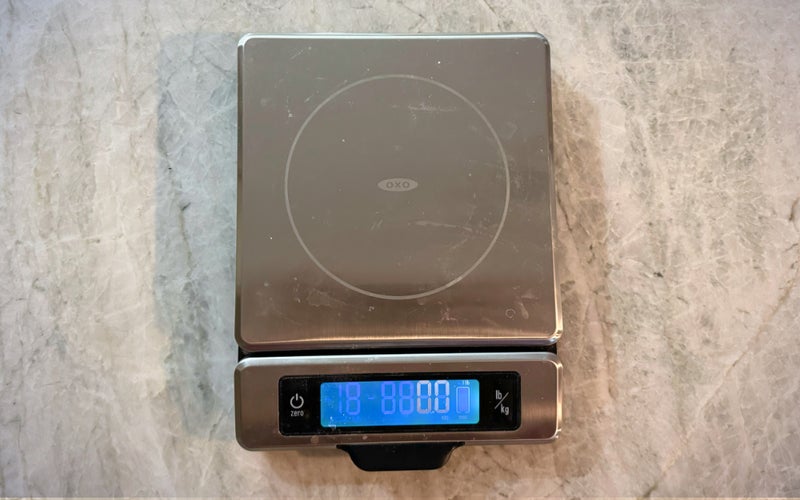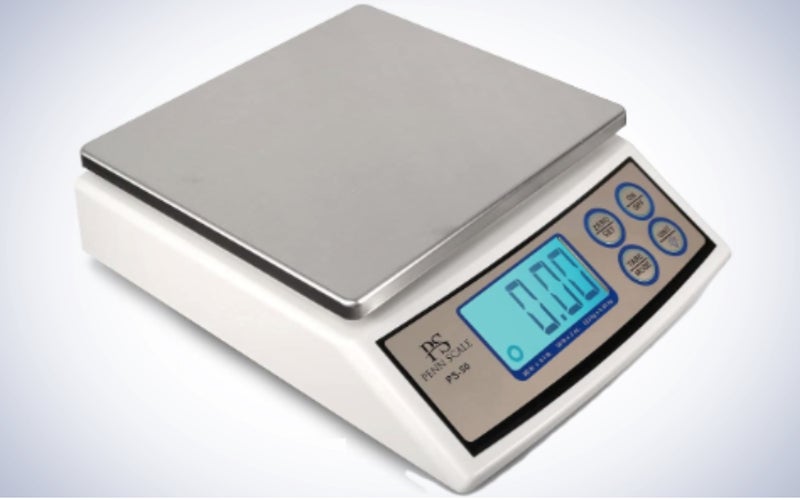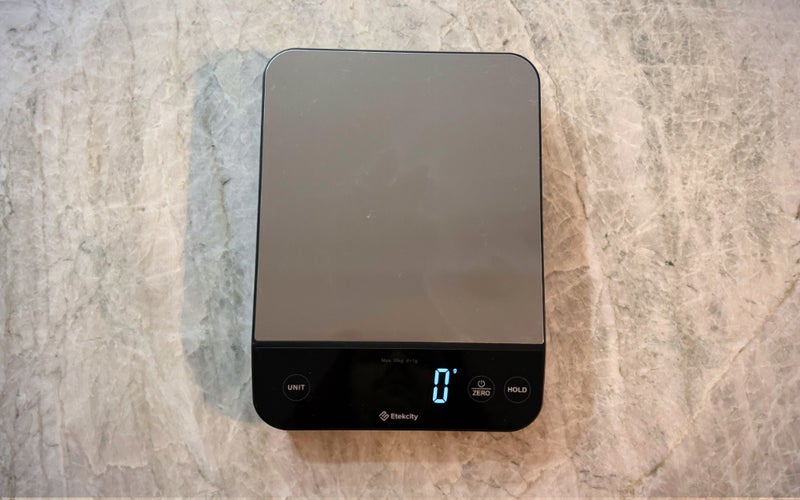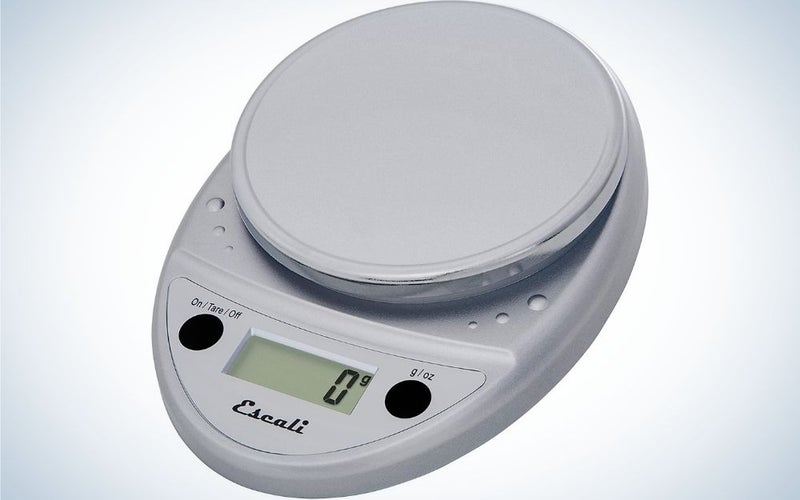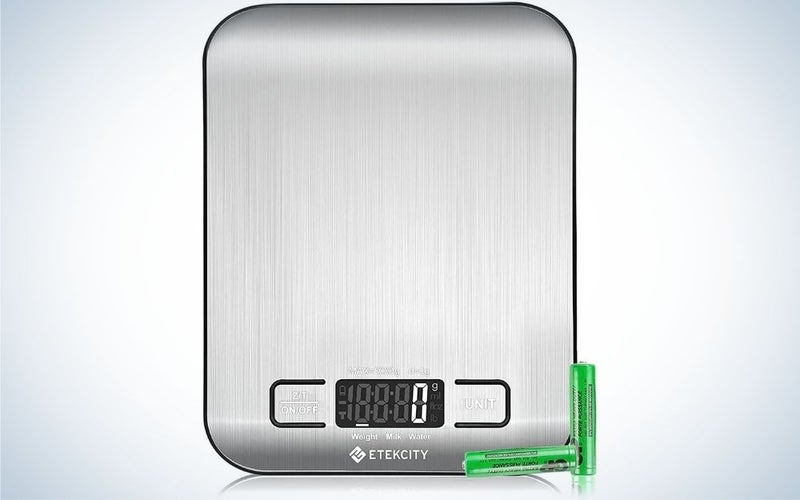We may earn revenue from the products available on this page and participate in affiliate programs. Learn more ›
A kitchen scale will elevate a regular kitchen to a cozy cafe or full-on bakery. Cooking is an art, but baking is a science. You can add a pinch of this and a fistful of that when cooking, but accurate measuring is necessary for baking cakes, bread, pastries, and pies. And tried-and-true volume measurements (gallons, cups, teaspoons, etc.) are anything but true. If you measure wrong or have some remnants stuck to the sides and bottom of your measuring device, your baked goods may turn out as baked awfuls.
Inaccuracy leads to frustration, but an electronic kitchen scale eliminates mishaps by showing accurate readings in every unit of food measurement needed. Plus, it makes it incredibly easy to use one bowl for mixing an entire recipe as you zero out the scale for each new addition to the party. Cooking scales have come a long way since the days of shaky seesaw balancing contraptions. Today’s best baking scales are digital wonders that offer rechargeable batteries, unique features, speedy measuring, and fun designs.
- Best overall: OXO Good Grips 11-Pound Stainless Steel Food Scale
- Best splurge: Penn Scale PS-50
- Best eco-friendly: Etekcity Rechargeable Food Kitchen Scale
- Best design: Escali Primo P115C Precision Kitchen Food Scale
- Best budget: Etekcity Digital Food Kitchen Scale
What to consider when shopping for the best kitchen scale
You could add the first kitchen scale you see into your Amazon cart, but before you assume all kitchen scales are the same, explore the newest features and styles on the market. From functions to display type, specific options may work best for your kitchen and cooking style. Or, for that matter, whether you’re investing in a coffee grinder to make the best pour-over. We conducted research and hands-on testing to determine the best models to recommend.
How we chose the best kitchen scales: Reviews & Recommendations
The two key issues of any great kitchen scale are functionality and style. The scale must be easy to read and understand. It should also look great, like a sleek, shiny platform that works with your kitchen decor. Take a close look at the specs and find the food weight scale you can easily understand and operate, which you’ll be proud to show off in your kitchen.
Best overall: OXO Good Grips 11-Pound Stainless Steel Food Scale
Brandt Ranj / Popular Science
Specs
- Size: 9.5 x 7.13 x 1.25 inches
- Maximum weight capacity: 11 pounds
- Measurement units: Ounces, grams, pounds
- Power source: AAA Batteries
Pros
- Pull out screen
- Accurate measurements
- Backlit display
Cons
- Price
If you’re ready to leave volumetric baking measurements aside for weight, OXO Good Grips’ 11-Pound Stainless Steel Food Scale is the one to get. It follows the company’s track record of elevating kitchen tools, from storage containers to grilling tools, to make them more accessible to home cooks. The big innovation with its kitchen scale is a magnetically attached display that can be moved a few inches forward. This lets you see the screen when weighing ingredients in a big bowl. In our experience, this has become an indispensable feature, making one-bowl baking recipes easier to manage.
We’ve used this scale to measure ingredients from countless recipes—especially when testing smart ovens or even microwaves—and it’s never let us down. The scale was accurate when measuring wet or dry ingredients, and we’ve even used it when weighing batters or doughs, which are a combination of both. You’ll have to pay a relatively steep price for this scale, but it’s worth it to have your recipes turn out every single time.
Best splurge: Penn Scale PS-50
Penn Scale
Specs
- Size: 12.7 x 10.5 x 3.4 inches
- Maximum weight capacity: 50 pounds
- Measurement units: Pounds, ounces, kilograms
- Power source: AA batteries, AC adapter
Pros
- Ultra-high weight capacity
- Multiple power sources
- HD display
Cons
- Large
Penn Scale’s PS-50 is the only kitchen scale we’re recommending that cracks three figures, and it’s best used by bakers who make food as a side hustle rather than the typical home cook. It can measure ingredients up to 50 pounds, which is helpful if you’re making a quintuple batch of chocolate chip cookies or cakes. Dessert meal preppers who want to knock out a quarter’s worth of baking at one time—or have cookie dough at the ready in case of emergencies—will benefit from the elevated weight capacity.
With its great weight city comes a great need for energy, which is why Penn Scale equipped the PS-50 with two power sources. You can use this kitchen scale portably by popping in a whopping six AA batteries (we prefer the best rechargeable batteries) or plug it into an outlet with the included A/C adapter. The latter limits where you can use the scale but is a little more eco-friendly. Another nice feature is this kitchen scale’s HD backlit screen, which displays its measurements clearly. If you’re upgrading from another kitchen scale because it can’t handle the volume of food you’ve cooking at one time, this is the one to get.
Best eco-friendly: Etekcity Rechargeable Food Kitchen Scale
Brandt Ranj / Popular Science
Specs
- Size: 9.1 x 6.7 x 1.1 inches
- Maximum weight capacity: 22 pounds
- Measurement units: Grams, ounces, pounds
- Power source: Rechargeable battery
Pros
- Runs on a rechargable battery
- High weight capacity
- Responsive buttons
Cons
- Requires a USB-A to USB-C cable
- Flat design makes it difficult to use with big bowls
If you’re trying to eliminate the number of batteries you have to keep around, Etekcity’s Rechargeable Food Kitchen Scale is a solid, eco-friendly solution. The scale can be plugged into any battery pack or power adapter with a USB-A port using the included cable to be topped up. Frustratingly, using a USB-C to USB-C cable will not work. In our experience, this kitchen scale was accurate enough that all of our recipes turned out regardless of the ingredients we were using. Its higher weight capacity allowed us to make a double batch of some recipes without running into any issues.
This kitchen scale has a relatively low profile, which is helpful when you need to get it into a drawer but a little frustrating if you’re trying to read its display when measuring ingredients in a large bowl. You’ll get the most accurate weight measurements when your bowl is centered on the scale, so you’ll need to be aware of its circumference. This typically wasn’t a big issue, but it’s something to be aware of if you like using wide bowls to measure ingredients when baking. With that caveat aside, Etekcity’s Rechargeable Food Kitchen Scale would be a great addition to any kitchen.
Best design: Escali Primo P115C Precision Kitchen Food Scale for Baking and Cooking
Escali
Specs
- Size: 8.5 x 6 x 1.5 inches
- Maximum weight capacity: 11 pounds
- Measurement units: Grams, ounces
- Power source: AAA batteries
Pros
- Elevated scale design
- Low battery indicator
- Available in several colors
Cons
- Tall size may make it difficult to fit in a drawer
The Escali scale has all the features you want in a kitchen scale: Accurate readings in 1-gram increments, long-lasting battery life, and a clear display. The scale runs on AAA batteries and will even flash an alert on its screen when they’re running low on power. What sets this popular baking scale apart from the others is the variety of color options. Tarragon Green, Pumpkin Orange, Royal Blue, Warm Red—you definitely can find an Escali kitchen scale to match your cooking space. You can also stick with the classic chrome, white, or black if you can’t decide on a funky hue. No matter what color you pick, the Escali kitchen scale is a precise tool that’s easy on the eyes.
Best budget: Etekcity Digital Food Kitchen Scale
Etekcity
Specs
- Size: 7.3 x 5.7 x 0.6 inches
- Maximum weight capacity: 22 pounds
- Measurement units: Ounces, pounds, grams
- Power source: AAA batteries
Pros
- Sleek look
- Slim size
- Price
Cons
- Harder to read the display when bowls are on it
This tiny, budget-friendly cooking scale is a good little kitchen tool to help amateur bakers and those looking for portion control. Accuracy and durability may slip slightly below the $15 mark. That said, it can still be useful for those needing a quick, cheap scale. It’s good for cooking but also useful DIY crafts with the kids. The LCD display is clear, and the buttons are easy to use.
The 7.3-inch by 5.7-inch scale is small enough to slip into any kitchen drawer, and the battery power lasts long if you use it only once or twice a week. However, this kitchen scale’s slim design has the same downside as the company’s rechargeable model: It will be hard to read its display when measuring ingredients in wide bowls. If you don’t want to invest in top-of-the-line kitchen equipment, this affordable scale is a good addition to your culinary toolbox.
What to consider when shopping for the best kitchen scales
Ready to have your mind blown? One cup of flour is not the same as another equally sized cup of flour; how you scoop and pack the flour into the measuring cup results in varying weights. And it gets even more confusing when switching between wet and dry ingredients. Volume measurements, like cups, tell you how much space an ingredient is taking up. It doesn’t tell you the weight. That imprecise discrepancy can cause big problems for baking, where accuracy makes or breaks the finished product. True bakers know the best way to measure ingredients is via weight, sometimes called mass measurement. One hundred grams of flour will always be 100 grams, whether you measure it in a cup, a bowl, a Frisbee, or a top hat.
Kitchen scales let you pinpoint precise weights easily, down to the gram or half-gram. You don’t need to worry about any residue left on the inside of measuring cups or spoons. You don’t need to wonder if an ingredient should be packed down or loose and fluffy. When mixing wet ingredients, you don’t need to fret over the small, convex peak caused by the liquid’s surface tension. (Yes, that matters and makes a difference.) And functions like translating ounces to grams mean you won’t need to run to the internet for conversion charts.
In addition, for those on strict diets who closely monitor what they eat, a food weight scale simplifies the chore of portion control. Basically, if you don’t have a kitchen scale, you’re making kitchen duty that much more difficult.
Power source
Even the most luxurious kitchens can have a wall outlet deficiency. Between plugging in blenders, food processors, magic pots, rice cookers, phone chargers, and the George Foreman grill, there’s no room in the outlet for new kitchen appliances. And adding bulky power strips to the kitchen makes the room look more like a workshop than a food-safe space. On top of that, it can be a pain dealing with cords for a kitchen accessory you may only use for a few seconds at a time. Fortunately, there are high-quality battery-operated kitchen scales for those who don’t have an outlet to spare. Choosing a cordless kitchen scale means you can use it on any flat surface, moving it near mixing bowls and frying pans for easy reach.
You can find kitchen scales that use standard AA or AAA batteries. They’re great for those who don’t plan to use the scale often and don’t mind buying batteries. Most have a surprisingly long battery life, powering through more than a few months on the same batteries.
Size
Professional bakers recommend using a kitchen scale capable of weighing at least 11 pounds. That sounds like a lot of weight, but it also accounts for the weight of your mixing bowl. Cooking accessories such as bowls can get surprisingly hefty.
You can go bigger and buy a kitchen scale capable of weighing items heavier than 20 pounds, but how often are you baking a bowling ball? And you can go much, much smaller with some portable kitchen scales designed to measure only between 1 and 100 grams. But those have limited uses, mostly for coffee aficionados who demand a perfect brew. If measuring anything less than 5 grams, you’ll need a jeweler’s scale, not a kitchen scale.
Display
Any great kitchen scale display must be easy to read. The digital font should be big enough to decipher, and the numbers should be simple to understand. Some kitchen scales display weight in fractions, some use decimals, and some do both.
Perhaps even more importantly, make sure you understand what the numbers mean. You may find kitchen scales that measure fluid ounces, and, as any middle-school science teacher will yell at you, “fluid ounces” are not the same as ounces. Fluid ounces are a measurement of volume. Ounces are a measurement of weight. This discrepancy can be deceiving and confusing. Make sure you understand what the scale is actually measuring. For weight, the numbers to look for are grams, pounds, and ounces.
What’s more, backlit displays can be helpful, but baking is usually done in a brightly lit kitchen where even non-illuminated displays can be read quickly and easily. One overlooked display factor: It should be visible even if a big mixing bowl is sitting on the platform. If the screen is blocked, look for a “hold” button that will keep the weight on-screen even when you remove the bowl.
Taring
Most scales offer a tare function. This simply means that with the touch of a button, the display will zero out the weight of whatever’s on the scale. For instance, start by putting a mixing bowl on the scale, then hit tare to zero out the bowl’s weight. Add your first ingredient, and hit tare again. Add your second ingredient, and so on.
Don’t overlook the tare function. This might be the single most important button on any kitchen scale. By taring the weight, you can use one bowl for all of your ingredients. You won’t need to clean countless measuring cups and multiple mixing bowls. Tare it up for quick, efficient baking!
FAQs
Q: How do I know if my kitchen scale is accurate?
To determine whether your kitchen scale is accurate, perform a few simple tests. You can buy special 5-gram and 10-gram weights made for scale calibration. These are relatively inexpensive, but you probably don’t need the hassle. Instead, plop a stick of butter on the scale. The scale should read 0.25 pounds or 4 ounces. If it doesn’t, read the instructional manual to learn how to calibrate your scale.
Simply put a nickel on the scale for the lactose intolerant or butter haters. Each U.S. nickel weighs 5 grams, so the scale should display 5 grams. Use clean coins that haven’t been worn down too much. This should tell you if the scale is ready to go.
Q: Can you store a digital kitchen scale on its side?
No, you shouldn’t store a digital kitchen scale on its side. Any scale sensitive enough to measure grams should be stored flat. The inner workings of the digital scale are made of delicate materials that may warp and deform if not stored correctly. The result is inaccurate results. If you do store the scale upright, put it through a few calibration tests (see above) before using it for serious baking.
Q: Are cheap scales accurate?
Cheap scales are very accurate—if used correctly. Inexpensive kitchen scales are great for measuring food portions. Most will have a tare button and a good display for mixing recipes. The lower price usually means less functions. Cheaper scales may not be able to measure in 0.5-gram increments, which can be important for some recipes. They may also have slower read times, adding a few half seconds to the baking process. That probably won’t matter much to the average person, but if you plan to use the scale often, slow calculations can be very frustrating. And if you measure weight less than 5 grams, you don’t need a kitchen scale, you’ll need a more precise jeweler’s scale.
Final thoughts on the best kitchen scales
- Best overall: OXO Good Grips 11-Pound Stainless Steel Food Scale
- Best splurge: Penn Scale PS-50
- Best eco-friendly: Etekcity Rechargeable Food Kitchen Scale
- Best design: Escali Primo P115C Precision Kitchen Food Scale
- Best budget: Etekcity Digital Food Kitchen Scale
No matter what type of food you’re preparing, a quality baking scale makes the recipe manageable. Find an electronic scale that fits your kitchen decor, from a small, green scale highlighting your style to a more substantial stainless-steel platform telling the world you know what you’re doing. Understand the difference between volume measurements (cups, fluid ounces, and teaspoons) and weight/mass measurements (pounds, ounces, and grams). It will become second nature once you wrap your head around that for a few meal prep sessions. With the right kitchen scale, you’ll be cooking up a storm and baking up a delicate French pastry like a pro.
Why trust us
Popular Science started writing about technology more than 150 years ago. There was no such thing as “gadget writing” when we published our first issue in 1872, but if there was, our mission to demystify the world of innovation for everyday readers means we would have been all over it. Here in the present, PopSci is fully committed to helping readers navigate the increasingly intimidating array of devices on the market right now.
Our writers and editors have combined decades of experience covering and reviewing consumer electronics. We each have our own obsessive specialties—from high-end audio to video games to cameras and beyond—but when we’re reviewing devices outside of our immediate wheelhouses, we do our best to seek out trustworthy voices and opinions to help guide people to the very best recommendations. We know we don’t know everything, but we’re excited to live through the analysis paralysis that internet shopping can spur so readers don’t have to.
